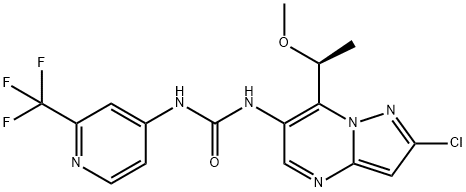Uses
MLT-943 is a potent, selective and orally active MALT1 protease inhibitor.?MLT-943 inhibits stimulated-IL-2 secretion in PBMC or in whole blood with a similar IC50?across species (0.07-0.09 μM in PBMC, 0.6-0.8 μM in whole blood). MLT-943 has anti-inflammatory?activities and can be used for FcgR-mediated inflammation research[1].
Biological Activity
MLT-943 is a potent, selective and orally active MALT1 protease inhibitor. MLT-943 inhibits stimulated-IL-2 secretion in PBMC or in whole blood with a similar IC50 across species (0.07-0.09 μM in PBMC, 0.6-0.8 μM in whole blood). MLT-943 has anti-inflammatory activities and can be used for FcgR-mediated inflammation research[1].
MLT-943 shows a high potency and selectivity in vitro. MLT-943 inhibits stimulated IL-2 secretion in PBMC or in whole blood with a similar IC50 across species (0.07-0.09 μM in PBMC, 0.6-0.8 μM in whole blood)[1].
MLT-943 (oral gavage; 10 mg/kg; QD) prophylactic treatment in the rat collagen-induced arthritis model suppresses anti-collagen antibody production, fully prevents paw swelling, and normalizes joint histology scores in rat model[1].MLT-943 (oral gavage; 5 mg/kg; QD; 10 consecutive days) effectively inhibits MALT1 protease activity and results in a progressive reduction in the frequency of Foxp3+CD25+ Treg cells in circulating CD4+ T cells, which was maximal after 7 days of treatment. And Discontinuation of MLT-943 treatment after day 10 leads to Treg frequency progressively returning to their original values within 4 days. Suboptimal doses of MLT-943 (0.1 and 0.5 mg/kg QD; p.o.) does not impact the Treg frequency[1].MLT-943 (oral gavage; 0, 5, 20 or 80 mg/kg/day; 4-13 weeks) causes a reduction in Treg and an increase in total T cell counts, in both 4- and 13-week rat toxicity studies at all dose levels. While a 4-Longer treatment induces severe immune-mediated pathology in multiple organs, with clinical onset starting around week 9 in rat[1].MLT-943 (p.o. admistration; 3 mg/kg; single dose) exhibits a good PK parameters in vivo. The Cmax values are 0.7 nM and 0.5 nM, respectively in rat and mice, respectively. And the F% are 86% and 50% in rat and mice, respective[1].For i.v. admistration the compound is formed in NMP:PEG200 (30/70); For p.o. admistration solution is formed in MC:Tween 80:Water (0.5:0.5:99) solution (Sourced from literature, for reference only)[1].
References
[1]. Kea Martin, et al. Pharmacological Inhibition of MALT1 Protease Leads to a Progressive IPEX-Like Pathology. Front Immunol [2]. Jean Quancard, et al. Optimization of the In Vivo Potency of Pyrazolopyrimidine MALT1 Protease Inhibitors by Reducing Metabolism and Increasing Potency in Whole Blood. J Med Chem. 2020 Dec 10;63(23):14594-14608.

